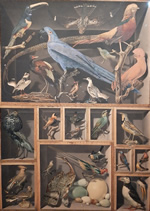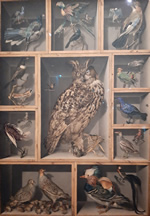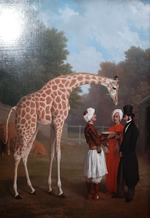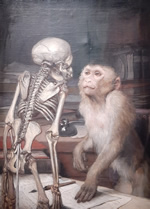Cabinets of curiosities
Cabinets of curiosities or chambers of wonder...“collecting science”
Enlightenment, Discovering the World in the Eighteenth Century , edited by Kim Sloan, The British Museum Press, 2003.
I. My notes on the book
- Ancient glory and modern learning: observation and experiment
- page 8: The birth of the Museum - importance of Newton and Locke
- page 12: Bacon
Men have been kept back, as by a kind of enchantment, from progress in the sciences by reverence for antiquity, by the authority of men accounted great in philosophy, and then by general consent.
Quoted in N.Hampson, The Enlightenment, p.35
If Enlightenment ideas found their intellectual expression in the creation of the British Museum in 1753, they found a visual expression in the Greek Revival architecture of the King’s Library, now so beautifully restored....
This room, the finest and largest Greek Revival interior in London, houses a permanent display, entitled Enlightenment: Discovering the World in the Eighteenth Century, and this book is published to explain the particular view of the Enlightenment embodied in the new gallery. It is by no means intended to be a comprehensive account of the period or its intellectual achievements. It seeks rather to examine the way people of the time looked at the ’natural and artificial curiosities’ being «collected» from all over the world, by scholars and collectors, who then sought to make sense of their past and their present.
R. Porter, Enlightenment: Britain and the Creation of the Modern World (Harmondsworth, 2000) pages 6-7.
New theories on the origins and age of the earth.
II. Les Origines du Monde: l’invention de la nature au siècle de Darwin.
(The Origins of the world, 15 December 2020-4May 2021 Musée d’Orsay exhibition).
Until the 18th century the world was viewed as a garden in which nature was subservient to man. During the Renaissance there was a proliferation of accurate descriptions of plants and animals in the first botanical and zoological treatises. Princes, humanists, and scholars created cabinets of curiosities featuring ’naturalia’ (natural objects) and ’mirabilia’ (unusual objects of wonder). Voyages of explorations encouraged the collection and acclimatisation in princely gardens and menageries, of species that were unknown in Europe. The fascination with large giraffes inspired artists.
The practice of collecting, inventorying, describing and classifying minerals, plants and animals seemed to be a re-enactment of Adam’s naming of the animals and brought the diversity of the ’new worlds’ within the orbit of christian civilisation.
Naming species forms the central pillar of the work of the Swedish naturalist Carl Linnaeus (1707-1778), the father of modern binomial nomenclature (combining 2 Latin names) and classification by class, order, genus, species and variety.
The Comte de Buffon (1707-1788), Director of the King’s Garden and Cabinet of Natural History (1739), also attempted a complete inventory of nature, but disregarded classifications.
Precursors of museums, their [cabinets of curiosities] aim was essentially to create a microcosm by distilling the essence of the universe.
« In a Small Compass, a Model of Universal nature made private ».
Francis Bacon, 1588, Gesta Grayorum.

- Réunion d’oiseaux étrangers
- Alexandre-Isidore Leroy de Barde (1777-1828)
Réunion d’oiseaux étrangers (vers 1810)
Aquarelle et gouache sur papier
[click on the picture to enlarge it]

- Oiseaux
- Alexandre-Isidore Leroy de Barde (1777-1828)
Oiseaux (1800-1828)
Aquarelle et gouache sur papier
[click on the picture to enlarge it]

- Giraffe
- Jacques-Laurent Agasse (1767-1849)
Giraffe
Huile sur toile, Londres, The Royal Collection Trust/HM Queen Elizabeth II
[click on the picture to enlarge it]

- Singe devant un squelette
- Gabriel von Max (1840-1915)
Singe devant un squelette (vers 1900)
Huile sur toile.
[click on the picture to enlarge it]
This Nubian giraffe, which was a gift to King Georges IV, is depicted with Edward Cross, head-keeper of Royal Surrey Gardens Menagerie in London.
With the proliferation of trade routes in the eighteenth-century, many exotic animals arrived in Europe. Some became celebrities.
> George III: a royal passion for science
Here we explore some of the most striking examples that were used to demonstrate mechanics, pneumatics and astronomy to the King and his household.
To enrich your discoveries You may also visit the Musée des Confluences
https://www.museedesconfluences.fr/...
Musée des Confluences: Though it is all in French...the richness of the resources and bibliography around this exhibition will give you an idea about the importance of the subject.
> Cabinets of Curiosities and The Origin of Collecting
> Cabinets of Curiosities and The Origin of Collecting
> British Library - Timelines: Sources from History
Even La Sorbonne, since the early 19th century, has had a Zoology Collection and now has a Cabinet of Curiosities for you to visit! ( 15 000 animals and anatomical pieces) Inauguration on October 4th 2021 by La Fondation Sorbonne Université, on the Pierre et Marie-Curie Campus.
> La collection de Zoologie, un cabinet de curiosités à explorer
And today, January 14th 2022, Futura published this extremely interesting article on a special stone called “paesine”: you can imagine it represents a landscape. Some can be seen at the Musée d’Histoire Naturelle in Paris at the Minerals and Geology Gallery.
> Cabinet de curiosités : la paésine, des paysages entiers capturés dans la pierre
> Muséum national d’Histoire naturelle (minéraux et gemmes)

